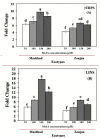Methyl Jasmonate Induces Genes Involved in Linalool Accumulation and Increases the Content of Phenolics in Two Iranian Coriander (Coriandrum sativum L.) Ecotypes
- PMID: 36292602
- PMCID: PMC9602312
- DOI: 10.3390/genes13101717
Methyl Jasmonate Induces Genes Involved in Linalool Accumulation and Increases the Content of Phenolics in Two Iranian Coriander (Coriandrum sativum L.) Ecotypes
Abstract
The medicinal herb coriander (Coriandrum sativum L.), with a high linalool (LIN) content, is widely recognized for its therapeutic benefits. As a novel report, the goals of this study were to determine how methyl jasmonate (MeJA) affects total phenolic content (TPC), LIN content, flavonoid content (TFC), and changes in gene expression involved in the linalool biosynthesis pathway (CsγTRPS and CsLINS). Our findings showed that, in comparison to the control samples, MeJA treatment substantially enhanced the TPC, LIN, and TFC content in both ecotypes. Additionally, for both Iranian coriander ecotypes, treatment-induced increases in CsγTRPS and CsLINS expression were connected to LIN accumulation in all treatments. A 24 h treatment with 150 µM MeJA substantially increased the LIN content in the Mashhad and Zanjan ecotypes, which was between 1.48 and 1.69 times greater than that in untreated plants, according to gas chromatography-mass spectrometry (GC-MS) analysis. Our findings demonstrated that MeJA significantly affects the accumulation of LIN, TPC, and TFC in Iranian C. sativum treated with MeJA, which is likely the consequence of gene activation from the monoterpene biosynthesis pathway. Our discoveries have improved the understanding of the molecular mechanisms behind LIN synthesis in coriander plants.
Keywords: coriander; gene expression; linalool; methyl jasmonate; total flavonoid content; total phenolic.
Conflict of interest statement
The authors declare no conflict of interest.
Figures




Similar articles
-
Change in Secondary Metabolites and Expression Pattern of Key Rosmarinic Acid Related Genes in Iranian Lemon Balm (Melissa officinalis L.) Ecotypes Using Methyl Jasmonate Treatments.Molecules. 2022 Mar 6;27(5):1715. doi: 10.3390/molecules27051715. Molecules. 2022. PMID: 35268816 Free PMC article.
-
Transcriptome profiling, and cloning and characterization of the main monoterpene synthases of Coriandrum sativum L.Phytochemistry. 2014 Jun;102:64-73. doi: 10.1016/j.phytochem.2014.02.016. Epub 2014 Mar 14. Phytochemistry. 2014. PMID: 24636455
-
Sedative effect of central administration of Coriandrum sativum essential oil and its major component linalool in neonatal chicks.Pharm Biol. 2016 Oct;54(10):1954-61. doi: 10.3109/13880209.2015.1137602. Epub 2016 Feb 25. Pharm Biol. 2016. PMID: 26911626
-
Coriander (Coriandrum sativum L.) and its bioactive constituents.Fitoterapia. 2015 Jun;103:9-26. doi: 10.1016/j.fitote.2015.03.012. Epub 2015 Mar 14. Fitoterapia. 2015. PMID: 25776008 Review.
-
Ethnobotanical and phytochemical aspects of the edible herb Coriandrum sativum L.J Food Sci. 2022 Apr;87(4):1386-1422. doi: 10.1111/1750-3841.16085. Epub 2022 Mar 12. J Food Sci. 2022. PMID: 35279837 Free PMC article. Review.
Cited by
-
Molecular and Physiological Evaluation of Bread Wheat (Triticum aestivum L.) Genotypes for Stay Green under Drought Stress.Genes (Basel). 2022 Nov 30;13(12):2261. doi: 10.3390/genes13122261. Genes (Basel). 2022. PMID: 36553528 Free PMC article.
-
Intraspecific divergence in essential oil content, composition and genes expression patterns of monoterpene synthesis in Origanum vulgare subsp. vulgare and subsp. gracile under salinity stress.BMC Plant Biol. 2023 Aug 7;23(1):380. doi: 10.1186/s12870-023-04387-5. BMC Plant Biol. 2023. PMID: 37550621 Free PMC article.
-
The Influence of Methyl Jasmonate on Expression Patterns of Rosmarinic Acid Biosynthesis Genes, and Phenolic Compounds in Different Species of Salvia subg. Perovskia Kar L.Genes (Basel). 2023 Apr 5;14(4):871. doi: 10.3390/genes14040871. Genes (Basel). 2023. PMID: 37107629 Free PMC article.
-
Identification of genes involved in verazine biosynthesis in Veratrum grandiflorum and their heterologous production in Saccharomyces cerevisiae.BMC Plant Biol. 2025 Jul 3;25(1):853. doi: 10.1186/s12870-025-06899-8. BMC Plant Biol. 2025. PMID: 40610854 Free PMC article.
-
Coriander (Coriandrum sativum) Polyphenols and Their Nutraceutical Value against Obesity and Metabolic Syndrome.Molecules. 2023 May 19;28(10):4187. doi: 10.3390/molecules28104187. Molecules. 2023. PMID: 37241925 Free PMC article. Review.
References
-
- Yilmaz A., Guler E., Soydemir H.E., Demirel S., Mollahaliloglu S., Karadeniz T., Ciftci V. Miracle plant: Aronia (Aronia melanocarpa) MAS J. Appl. Sci. 2021;6:83–94.
-
- Yilmaz A., Karik Ü. AMF and PGPR enhance yield and secondary metabolite profile of basil (Ocimum basilicum L.) Ind. Crops Prod. 2022;176:114327. doi: 10.1016/j.indcrop.2021.114327. - DOI
-
- Arif M., Khurshid H., Khan S. Genetic structure and green leaf performance evaluation of geographically diverse population of coriander (Coriandrum sativum L.) Eur. J. Acad. Res. 2014;2:3269–3285.
-
- Bhat S., Kaushal P., Kaur M., Sharma H.K. Coriander (Coriandrum sativum L.): Processing, nutritional and functional aspects. Afr. J. Plant Sci. 2014;8:25–33.
Publication types
MeSH terms
Substances
LinkOut - more resources
Full Text Sources
Research Materials
Miscellaneous

